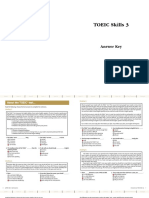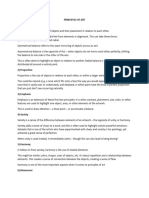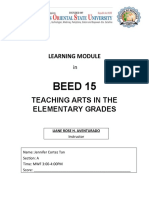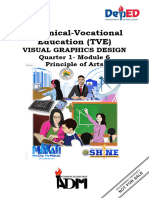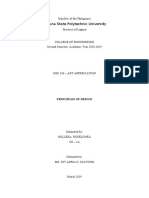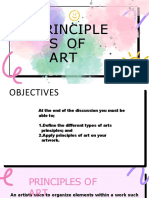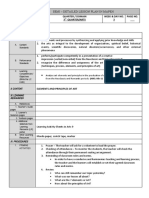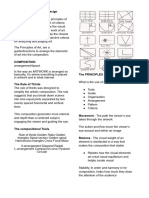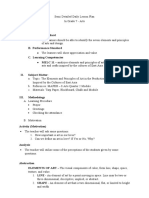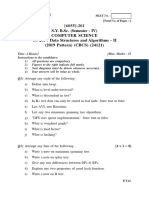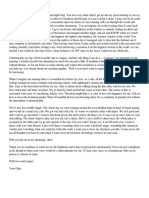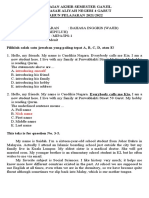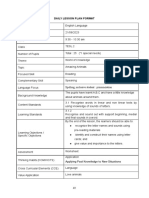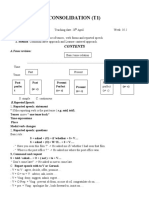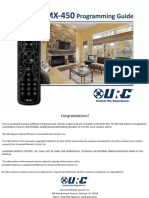Elective Lesson Plan
Uploaded by
verdaderogemma05Elective Lesson Plan
Uploaded by
verdaderogemma05LEARNING OBJECTIVES
At the end of the lesson, the student should be able to:
A. Identify the different principles of art
B. Describe the importance of applying the principles of art
C. Create an artwork by applying different principle of art
SUBJECT MATTER
Materials: Instructional materials, visual aids, pictures
Topic: Principles of art
References: Grade 8. Music and arts Unit II
Google images,
https://www.studocu.com/ph/document/our-lady-of-fatima-university/art
Reading visual arts module
Appreciation/activity-1-midterm/35671005
PROCEDURE
A. Preliminary activities
1. Greetings
2. Prayer
3. Classroom management 4. Checking of attendance
4. Review
(The teacher will review and call students to answer the questions about the
Previous lesson)
What was the topic last meeting?
What are the different elements of arts?
5. Motivation
(The teacher will group the students into 3 members and each group will analyze the jumbled
letters in 3 minutes and the group who will get the highest
Number of correct is the winner)
1. CLANBAE (Balance)
2. INTOPROORP (proportion)
SHPISME (Emphasis)
3. RATYIEV (Variety)
. TINYU (Unity) 5
6. VNTEEOMNM (Movement)
7. MHTYHR (Rhythm)
8. RENTTAP (Pattern)
IN
LESSON PROPER
A. Activity
(The teacher will show different pictures of drawings showing the different principles apply in
the artworks and let the student try to analyze and observe the picture)
B. Analysis
(The teacher will now discuss the principles of arts, Balance, Proportion, Emphasis, Variety,
Harmony, Movement, Rhythm, pattern, contrast, Repetition)
The principles of art are the fundamental rules that artists use to compose a painting, drawing or
sculpture. The principles are balance, harmony, unity, pattern, repetition, rhythm, contrast,
emphasis, variety, movement, scale and proportion. These principles are used in combination
with one another to create aesthetically pleasing compositions and designs.
The 10 principles of art
BALANCE in an artwork creates a sense of equilibrium. Artists can create balance by arranging
elements with equal or similar visual weight around the canvas. It can be achieved through
Symmetrical or asymmetrical arrangement of the elements.
• Symmetrical balance is when both sides of an artwork have equal weight or look identical
Asymmetrical balance is when the elements are unbalanced but still maintain a sense of visual
equilibrium
PROPORTION It is about the relationship and size of one object to another.
EMPHASIS it is concerned with the dominant feature or center of interest of a work of art.
Artists use emphasis to draw their audience into the most important part of the composition
VARIETY is a sense of the difference between elements of an artwork-the opposite of unity, or
Harmony. Variety adds a sense of chaos to a work, and this is often used to highlight certain
Powerful emotions UNITY- is the feeling of harmony between all parts of the works of art,
which creates. A sense of completeness. The sense of feeling that everything that fits together.
MOVEMENT This indicates the direction your eye takes as you view the work in what order
does your eye travel? If the emphasis is used, this often means you start with this element first
and travel away from it.
RHYTHM It is a combination of elements repeated, but with variations. When motifs or
elements are repeated, alternated, or otherwise arranged, the intervals between them or how they
overlap can create rhythm and a sense of movement.
PATTERN It is the repetition of more than one design element. While repetition focuses on a
single element being repeated, pattern refers to multiple elements repeated throughout a design
(e.g. wallpapers and backgrounds)
C. ABSTRACTION
(The teacher will give or ask the student to give the summary of the discussion)
1. When we say fundamental rules that artists use to compose a painting, it is the:
(PRINCIPLES OF ARTS)
II. Talking about principles of art, we have different principles namely? (Balance, proportion,
emphasis variety,unity.movement, rhythm pattern)
III. What are the 2 types of balance?
(symmetrical and asymmetrical balance)
D. APPLICATION
• Together with a partner, the teacher will let the student choose 1 art principle and together they
will make an simple sketch showing the principle that they’re chosen.
V. EVALUATION
The teacher lets the student write an explanation in their own words about the importance of
applying the different principles of art in making an artwork.
IV. ASSIGNMENT
Create an original artwork using any medium of your choice (painting, drawing, digital art, ).
The theme is “Nature’s Beauty.” Apply 2 or more principle of art that we tackled. The orientation
of the artwork should be in landscape and also make a brief explanation about your art with title.
You might also like
- Puzzles Predicaments and Perplexities III v1.1100% (8)Puzzles Predicaments and Perplexities III v1.142 pages
- Midterm - Beed 119 - Principles of Art-1No ratings yetMidterm - Beed 119 - Principles of Art-124 pages
- Quarter 1 - Module 4: Arts and Crafts of LuzonNo ratings yetQuarter 1 - Module 4: Arts and Crafts of Luzon29 pages
- The Language of Art: Elements and PrinciplesNo ratings yetThe Language of Art: Elements and Principles38 pages
- 8TVE ICT Visul-Graphic q1 Module6 DELOS-SANTOS-CB For Printing JLMNo ratings yet8TVE ICT Visul-Graphic q1 Module6 DELOS-SANTOS-CB For Printing JLM11 pages
- Lesson 6 - Elements and Principles of Art (Part 5-6) - 1No ratings yetLesson 6 - Elements and Principles of Art (Part 5-6) - 145 pages
- Laguna State Polytechnic University: Republic of The PhilippinesNo ratings yetLaguna State Polytechnic University: Republic of The Philippines3 pages
- Principles in Understanding Artistic CompositionNo ratings yetPrinciples in Understanding Artistic Composition16 pages
- Teaching Arts in Elementary Grades: LESSON 3: PRINCIPLES OF ARTNo ratings yetTeaching Arts in Elementary Grades: LESSON 3: PRINCIPLES OF ART16 pages
- Daily Lesson Plan ARTS Quarter 2 December 1 2022No ratings yetDaily Lesson Plan ARTS Quarter 2 December 1 20223 pages
- Presentation English For Oral Communication OUMH 1303 Presentation English For Oral Communication OUMH 1303No ratings yetPresentation English For Oral Communication OUMH 1303 Presentation English For Oral Communication OUMH 130323 pages
- The First Ninety Years A Sumerian Celebration In Honor Of Miguel Civil Llus Feliu Editor Fumi Karahashi Editor Gonzalo Rubio Editor download100% (1)The First Ninety Years A Sumerian Celebration In Honor Of Miguel Civil Llus Feliu Editor Fumi Karahashi Editor Gonzalo Rubio Editor download83 pages
- A Hindi Speech Recognition System For Connected WoNo ratings yetA Hindi Speech Recognition System For Connected Wo8 pages
- Operating System As A Resource Manager - With ExampleNo ratings yetOperating System As A Resource Manager - With Example5 pages
- Plus Two Annual Exam 2025 Accountancy wih CA Answer KeyNo ratings yetPlus Two Annual Exam 2025 Accountancy wih CA Answer Key8 pages
- Past Simple and Past Continuous: GrammarNo ratings yetPast Simple and Past Continuous: Grammar3 pages
- Microsoft Certified: Data Analyst Associate - Skills MeasuredNo ratings yetMicrosoft Certified: Data Analyst Associate - Skills Measured4 pages

